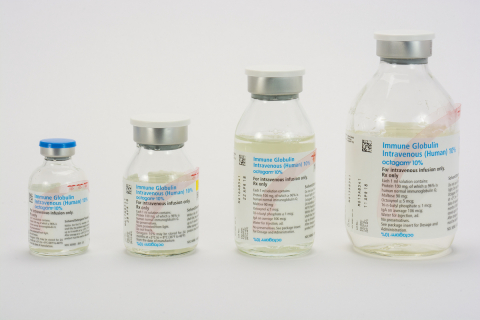HOBOKEN, N.J.--(BUSINESS WIRE)--The U.S. Food and Drug Administration (FDA) has granted Octapharma USA orphan drug designation for Octagam® Immune Globulin Intravenous (Human) 10% Liquid for the treatment of dermatomyositis, a rare acquired disorder characterized by chronic inflammatory and degenerative changes of the muscles and skin.1
“We are pleased that the FDA has granted orphan drug designation to Octagam® 10% for the treatment of dermatomyositis,” said Octapharma USA President Flemming Nielsen. “Octapharma is committed to providing patients with life-enhancing and life-saving therapies. Helping patients with chronic diseases such as dermatomyositis maximize their quality of life is central to Octapharma’s mission and culture.”
The cause of dermatomyositis is unknown. The disorder’s main symptom is a skin rash that precedes or accompanies progressive muscle weakness. The disease is most common in children between ages 5 and 15 and adults in their late 40s to early 60s, but can occur at any age. There is no cure for dermatomyositis.1 The estimated incidence of dermatomyositis is 9.63 cases per million population.2
The FDA Orphan Drug Designation program provides orphan status to drugs and biologics, which are defined as those intended for the safe and effective treatment, diagnosis or prevention of rare diseases/disorders that affect fewer than 200,000 people in the U.S., or that affect 200,000 or more people, but where sales are not expected to recover the costs of research and development of the product.
About Octagam® 10%
Octagam® 10% is an immune globulin intravenous (human) liquid preparation indicated for the treatment of chronic immune thrombocytopenic purpura (ITP) in adults.
WARNING: THROMBOSIS, RENAL DYSFUNCTION and ACUTE RENAL FAILURE
Please see full prescribing information for complete boxed warning.
- Thrombosis may occur with immune globulin intravenous (IGIV) products, including Octagam® 10%. Risk factors may include: advanced age, prolonged immobilization, hypercoagulable conditions, history of venous or arterial thrombosis, use of estrogens, indwelling vascular catheters, hyperviscosity, and cardiovascular risk factors.
- Renal dysfunction, acute renal failure, osmotic nephropathy, and death may occur with the administration of immune globulin intravenous (human) (IGIV) products in predisposed patients. Renal dysfunction and acute renal failure occur more commonly in patients receiving IGIV products containing sucrose. Octagam® 10% does not contain sucrose.
- For patients at risk of thrombosis, renal dysfunction or renal failure, administer Octagam® 10% at the minimum infusion rate practicable. Ensure adequate hydration in patients before administration. Monitor for signs and symptoms of thrombosis and assess blood viscosity in patients at risk for hyperviscosity.
CONTRAINDICATIONS
Octagam® 10% is contraindicated for patients with a history of anaphylactic or severe systemic reactions to human immunoglobulin; and IgA deficient patients with antibodies against IgA and a history of hypersensitivity.
For more information and full prescribing information on Octagam® 10%, please visit www.octagamus.net.
About the Octapharma Group
Headquartered in Lachen, Switzerland, Octapharma is one of the largest human protein products manufacturers in the world and has been committed to patient care and medical innovation since 1983. Its core business is the development and production of human proteins from human plasma and human cell lines. Octapharma employs approximately 7,100 people worldwide to support the treatment of patients in over 113 countries with products across the following therapeutic areas: Hematology (coagulation disorders), Immunotherapy (immune disorders) and Critical Care. The company’s American subsidiary, Octapharma USA, is located in Hoboken, N.J. Octapharma operates two state-of-the-art production sites licensed by the U.S. Food and Drug Administration (FDA), providing a high level of production flexibility. For more information, please visit www.octapharmausa.com.
REFERENCES
1 – Dermatomyositis; U.S. Department of Health & Human Services, National Institutes of Health, National Center for Translational Sciences, website: https://rarediseases.info.nih.gov/diseases/6263/dermatomyositis, accessed April 21, 2017.
2 – Dermatomyositis; National Organization for Rare Diseases, website: https://rarediseases.org/rare-diseases/dermatomyositis/#affected-populations, accessed April 21, 2017.
GAM10-0133




